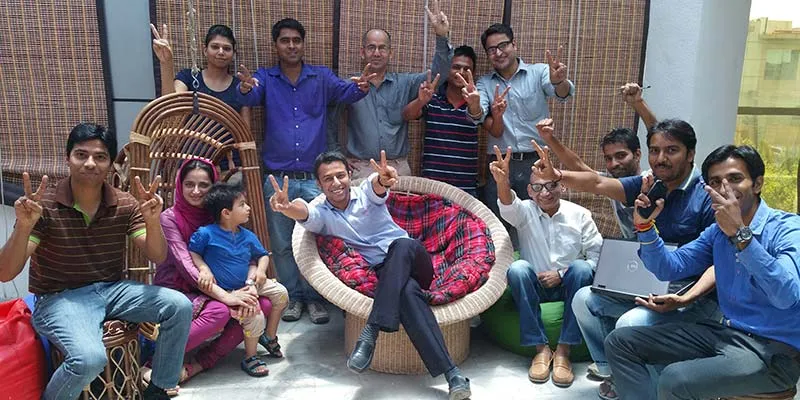Yebhi co-founder exits to start ‘anti-e-commerce’ venture Shopsity
In 2007, 24-year-old Danish Ahmad built India’s first online shoe store, Bigshoebazaar.com. The company eventually went on to become Yebhi.com, employing 1500 people and one of the early successes of India’s e-commerce story. Last year the company pivoted from the marketplace to the product discovery model after not being able to raise funds.
Now at 32, Danish is set to start off the second innings of his entrepreneurial journey. But there’s a small twist, his internet venture this time is anti-e-commerce. YourStory spoke to Danish to know more about his plans to bring offline shopping experience and online discovery together.

Accommodating the anti-e-commerce sentiment
Danish started working on Shopsity idea in 2014 and finally launched in March 2015. He’s the sole founder of the startup which is 12-member strong now. He says,
In Yebhi, I realised that a lot of people are shopping online not because it is convenient, but because the alternate is so inconvenient. People were choosing to wait for three days, risk a wrong size and buy without touching, against the alternate of going from store to store, mall to mall.
According to Danish, e-commerce was efficient but boring and unnatural, while shopping was laborious but fun. Shopsity is trying to bring the convenience of online shopping with the experience of offline shopping. It’s a mobile app where you get to see what’s selling in stores nearby. The app lists multiple designs, latest offers and allows the user to make a shopping list.
In simple terms, Danish sees Shopsity’s experience similar to what Zomato offers for food.
Etail v/s retail
In the US and China, where e-commerce is a decade-old phenomenon, 80% of ‘non-food’ shopping (retail) still happens offline, and that number is not falling sharply. Danish believes that this is an indication of user stickiness to the experience model, despite the heavy discounting and marketing strategy of retailers. He says,
Etail isn’t more cost effective than retail. The logistics cost is increasing and the current discounts are coming out of marketing budgets and they will taper down. I believe that retail is at an inflection point and the next five years will see a retail revolution.
Danish pictures a year from now to have thousands of retailers that’ll connect, engage and transact with customers digitally (through Shopsity). He further expects retailers offering personalised recommendations and discounts and advertising on Facebook and Google, offering a much richer user experience. Shopsity is a platform connecting consumer and retailer, which keeps people updated with not only the latest offers, but also sharing what others are buying or liking.

What changes and what doesn’t
According to Danish, the following remains the same for both e-commerce and Shopsity:
- The way to approach a customer.
- Using data to personalize offering to customer.
- Solve the problem of discoverability and right match-making.
However, a few factors are different when comparing the two segments like:
- The altered experience for the consumer.
- One can show more based on consumer’s reaction and make changes in the offering more quickly and effectively.
- Features like ‘book a cab to go the nearest store’ can be integrated.
Capital – infusion and generation
Shopsity will be generating revenues by charging a listing fee to the stores on their platform. The listing is free for the first few days and then will cost depending on multiple factors. Right now, brands like Woodlands, Red Tape, Lotto, Nike, Numerouno, Catwalk and others are already listed in the platform. Speaking about profitability, Danish says,
Unlike online shopping, I’m not asking people to change their habit, and hence the inertia is less in this type of business. Accordingly, a lower sum of capital is required for acquiring and retaining the customers.
Danish is looking at raising $4-5M funding for the next one year of operations.
Shopping @ Shopsity
Right now, the company is focussed on fashion and running pilots. It has more than 2000 stores from Delhi/NCR, already listed on its Android app. Danish plans to expand Shopsity’s operations to other cities starting from July. Over the next year, the company is targeting to list over 40,000 fashion stores across the top 10 cities on its platform.
NCR-based Zakoopi and Bengaluru-based Retale are also operating in the same domain but there’s no market leader at the moment. As far as Shopsity is concerned, their biggest challenge is to cater to the non-branded stores which are showing a lot of interest to get listed. Deploying foot soldiers, getting their catalogue on Shopsity and marketing remain the biggest challenges for Danish. The company plans to take digital marketing channels as well as market activation channels for reaching out to customers.
Danish says,
Retail is going to be very different in the next five years. Till now we have only been consolidating which is not very powerful. Now that the users are getting used to the tech, it’ll be much easy to integrate the online and offline shopping experience to make a better offering.







